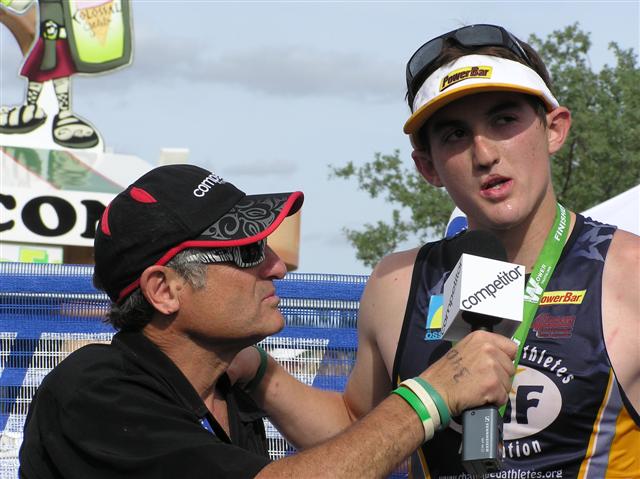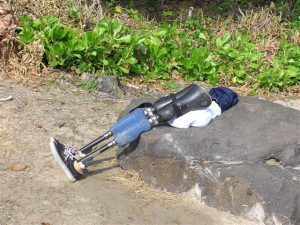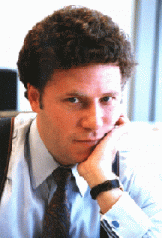Lee Gruenfeld profiles the amazing Rudy Garcia-Tolson

About fourteen years ago, me bride Cherie was swimming laps in a pool in Rialto, California, minding her own business, when she was suddenly struck by a torpedo. She turned around and was only able to glimpse the offending bit of waterborne ordnance long enough for it to pop its little head up and mumble "Sorry!" before it shot off toward the far wall. Luckily, she was able to scramble into an adjacent lane and thereby avoid a second attack.
But as she watched the missile fly by on its return path, she noticed that it was all bow and no stern, its propulsive power deriving exclusively from a set of churning arms with no secondary wake where the legs should have been. Conversing with the torpedo’s mother after the workout, she learned that she’d been rammed by a seven-year old boy named Rudy who didn’t have legs but did have about eleven different ways of overcompensating for their absence. Barreling heedlessly past 50-year old women lollygagging in his lane made it an even dozen. (The "lollygagger," by the way, had just won her age division at the Ironman World Championships in Kona, clearly impressing the hell out of young Rudy.)
Six months after that chance encounter, Rudy competed in a triathlon with brother Richard doing the bike and Cherie the run as relay partners. For Rudy, that event wasn’t some "I’m just happy to be competing" assertion of his independence accompanied by soaring violins and teary-eyed onlookers. When I stuck a video camera in his face and asked him what his goal was, he homed right in on the lens and said, "We’re gonna kick butt!" Ninety minutes later he was on the medal stand.
Fourteen years later, he’s here in Kona trying to become the first double above-the-knee amputee to compete in and complete a full Ironman. And, no surprise, he’s chosen the toughest course in the world to do it on.
* * *
Rudy was born with enough physical calamities to challenge half a dozen lives. The worst of it was in his legs, which were sufficiently afflicted to require fifteen surgeries by the time he was five. After fifteen surgeries you kind of start to get the feeling that maybe doing the same thing over and over and not getting a different result isn’t the best way to spend your life. The surgeons apparently thought so, too, but how do you get a seven-year old to understand that?
"Am I ever going to run around with other kids on these?" Rudy asked, pointing to his scarred, twisted limbs.
"Doubtful," the surgeons replied. "Your best bet is a set of prosthetic legs."
Rudy thought it over for a good three seconds. "Fine," he announced, in a tone indicating that there was no need to phone up the pre-amputation psych counselor. "Get rid of ‘em."
They got rid of ‘em, and thus was created the torpedo. Six years later he became the youngest challenged athlete to earn a medal at the USA Swimming National Disability Championships, setting the U.S. record in the 200m breaststroke. The following year he set a national record in a half marathon, then broke it himself the year after that.
In 2002 he was an opening day speaker at the Paralympics in Salt Lake City, where he also carried the torch. Two years later at the Paralympics in Athens he won his first international gold medal and set a new world record in the 200m individual medley. There would be more of those – gold medals and world records both – in the years following, including in Beijing last year.
Then he decided to get serious. Ironman had been in the back of his mind ever since his first tri, but it wasn’t until he saw the magnificent Sarah Reinertsen do it that he made up his mind. Sarah is a "single above" (one leg, above-the-knee amputee) who first attempted the Kona course in 2004 but missed the bike cutoff by fifteen minutes. She came back the following year (a simple phrase, that, but it tells you most of what you need to know about these kinds of people) and this time blasted across the finish line with nearly two hours to spare.
That’s all Rudy needed. He started training in 2007 and moved to the Olympic Training Center, but he got a little distracted while breaking those world swimming records and didn’t really crank up the Ironman training until he got back from Beijing in 2008.
He’s had help, from a wide variety of sources. First among them is Ironman Hall-of-Famer Bob Babbitt, co-founder of the Challenged Athletes Foundation and one of the planet’s staunchest and most tireless advocates for the idea that the label "athlete" applies to a lot more people than we’d think. Paul Huddle has provided training plans, the Ossur company provides "prosthetic legs for every occasion," Cherie has taken him for long bike rides in 115-degree desert heat, there’s veteran Ironman wheelchair racer David Bailey, the PowerBar people…the list goes on.
On race day, however, despite the crowds who will be cheering him on at several widely separated points on the course, Rudy will be alone, like a boxer accustomed to a fifty-man entourage who steps into the ring and suddenly realizes that every
* * *

Triathlon is tough enough on two good legs. The challenges facing Rudy at the Ironman are formidable.
His strength is in the swim. It’s where he least misses not having lower legs. While he doesn’t get the benefit of roll stabilization or the extra bit of propulsion from kicking, he also doesn’t suffer the drag that afflicts two-legged swimmers. (Ever notice that the best swimmers in the world have long torsos and short legs?)
He’s also got the run under control. He uses a special pair of legs that make him look like he’s standing atop two letter C’s. The little bit of spring action in those half-circles of fiberglass substitute for the natural springiness of ankles and calves under a hinge-like knee. What they don’t do is retract the trailing foot upward as it’s brought forward so that it clears the ground before being planted in front again. So instead of bringing the back foot straight forward under him, he has to swing it outward in a wide arc. (Word to athletes who think it’d be neat to run next to him this Saturday: Treat him like you would one of those chariots with the spiked wheels in Ben Hur and give him a wide berth.)
He’s also about two feet shorter than usual when he runs, having figured out that being close to the ground is a lot more stable than being high in the air. Choosing your own height is one of the few really cool advantages of having prosthetic legs.
The bike is where things really get squirrelly. Rudy doesn’t have quads or hamstrings to call on and has to push through 112 miles relying solely on his glutes. He also can’t stand up on the pedals, which means that he has to ascend steep hills sitting down. Other triathletes do that, but not being able to stand up has another nasty implication, and that is that he’s got no way to give his butt a break once in a while. It’s planted on that seat for the duration. And if he feels himself getting blown over by a side wind? Snapping his shoes out of the pedals quickly is quite a trick.
When he was ten years old, Rudy became the youngest bilateral amputee to complete a triathlon on his own. In 2007 he became the first "double above" to complete a half Ironman. Last year he conquered the Wildflower long course, proving that he could handle towering hills on the bike, and a few weeks later he threw in the Honu half Ironman, laying to rest any doubts that he could tolerate debilitating heat and miles of running on grass.
Saturday will be different. Not just linearly longer but exponentially harder. Rudy is one of the toughest guys I’ve ever met but finishing this course is far from a Disney-esque, cue-the-swelling violins certainty. Two years ago I was at the finish line when Scott Rigsby, another tough-as-nails sonofagun, became the first double amputee to finish the Ironman on prosthetic legs. Scott is a double below-the-knee amputee who still has his own knees and a good set of quads, and yet there were fewer than seventeen minutes left against the 17-hour cutoff when he triumphantly broke the tape.
Here’s what Rudy’s up against:
The swim: "I can do it in under an hour," he told me yesterday. Yes, he can. And he doesn’t plan to be lifted out of the water, as is the custom with challenged athletes. He’s going to run out of the water on his bare stumps and put on a pair of walking legs. When he gets to his bike, he’ll exchange those for biking legs and take off.
"One thing I learned at Honu," he said, "is to take the time to get all the sand off my shorts." At the Honu 70.3, he didn’t do that, and suffered for it mightily when sand got between his stumps and the sockets in his prosthetics and ground into his skin with every pedal stroke.
The bike: I would have thought the bike would give him the most trouble, because of the hills, but he’s not worried about it. "I rode the hardest part of the course at Honu," he says, "and got through it all right. So I know that if I take it easy I can handle twice the distance." He’s also got updated biking legs that he and his prosthetist came up with.
What about the infamously fierce side winds, the same ones that blew Madonna Buder clear off her bike three years ago and resulted in a broken clavicle?
"If they come, they come," he says with smile and a shrug. "I’ll deal with them."
Target time: Eight hours
The run: Despite his prowess as a runner, this is the piece that concerns him the most.
"I have the strength and the endurance," he asserts. "The problem is the effect on my stumps."
Rudy’s never run more than twenty miles and, even at that distance, which is a full 10K shorter than the full marathon that comprises the last leg of Ironman, the pain was significant..and it didn’t come after a 112-mile bike ride. No configuration of his prosthetics can completely avoid the constant rubbing against his skin, and he has no idea how much worse it’s going to be not only at the longer distance but after the trauma of (at least) eight hours of cycling.
"If I’m ahead of the clock and there’s time," he told me, "I’m fully prepared to sit down right on the road and take the occasional breather."
He did it at Wildflower, removing both legs and letting them breathe. "The only problem," he said with a laugh, "is that people running by kept stopping to offer help! I had to keep explaining that I was just taking a break."
Rudy knows a thing or two about pain, especially the distinction between when he should muscle his way past it or listen to the signs and ease up before too much damage is done. It’s a virtual certainty that he’s going to bang right up against that decision point this Saturday, not only because he’s putting himself where he’s never been before but he’s doing it with a new challenge he hadn’t anticipated: Two weeks ago one of his stumps became inflamed and warm to the touch. When it swelled up alarmingly he was put on antibiotics. He hasn’t run since, and won’t until race day, which is not the best way to handle the run-up to an Ironman.
When I asked him about all of this, he waved the question away. "There’s no decision to be made," he said. "I’m finishing this race."
What about potential damage?
"Doesn’t matter. I know it’s not smart but if I can move forward, I will, no matter what."
Which brings us to the question of why he’s doing this race in the first place.
* * *
Rudy had never planned to be the poster child for overcoming adversity. (I mean that literally: He’s on posters about overcoming adversity.) In retrospect, however, it was inevitable.
My own take on his life is that it’s not about achieving but striving. His mantra is "What’s next?" because what’s past isn’t worth dwelling on and winning medals and setting world records aren’t the answers; they’re the questions: If I did that, what’s to say I can’t do something more?
Rudy’s odyssey began as a self-oriented one but gradually morphed as his world view expanded. He’s been a source of wonder and admiration for a long time, but it took a while for him to realize that he was a source of inspiration as well, not just indirectly as a model for rising above one’s circumstances in general, but directly: There are kids out there with missing limbs and other infirmities who believe that leading limited lives is their lot and the sooner they accept it and stop fighting it, the better off they’re going to be.
Imagine a legless kid in a wheelchair thinking he’s going be there for life accidentally channel-surfing his way to a certain television show in December and finding some other kid who looks just like him doing a freaking Ironman.
Primarily as a result of his involvement with the Challenged Athletes Foundation, Rudy is keenly aware of that kid and his own effect on him. His impact on that community has already been profound. "But if I finish an Ironman?" he muses aloud. Then he shakes his head, answering his own question. "Those kids are going to believe there’s nothing they can’t do."
My own feeling is that that’s what they’re going to think as soon as Rudy steps up to the starting line, whether he finishes or not.
Fortunately for the people all over the world who are going to be following him on race day, that’s not the way Rudy thinks.
